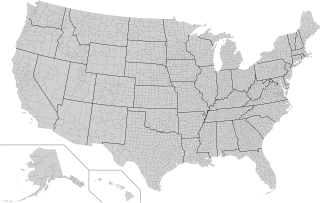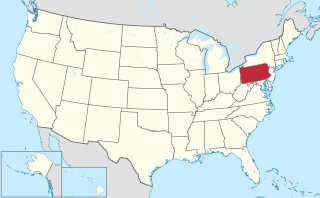Related Research Articles

A borough is an administrative division in various English-speaking countries. In principle, the term borough designates a self-governing walled town, although in practice, official use of the term varies widely.

In the United States, a county is an administrative or political subdivision of a state that consists of a geographic region with specific boundaries and usually some level of governmental authority. The term "county" is used in 48 U.S. states, while Louisiana and Alaska have functionally equivalent subdivisions called parishes and boroughs, respectively.
A civil township is a widely used unit of local government in the United States that is subordinate to a county. The term town is used in New England, New York, and Wisconsin to refer to the equivalent of the civil township in these states. Specific responsibilities and the degree of autonomy vary based on each state. Civil townships are distinct from survey townships, but in states that have both, the boundaries often coincide and may completely geographically subdivide a county. The U.S. Census Bureau classifies civil townships as minor civil divisions. Currently, there are 20 states with civil townships.

The administrative divisions of New York are the various units of government that provide local services in the State of New York. The state is divided into boroughs, counties, cities, townships, called "towns", and villages. They are municipal corporations, chartered (created) by the New York State Legislature, under the New York State Constitution the only body that can create governmental units in the state. All of them have their own governments, sometimes with no paid employees, that provide local services. Centers of population that are not incorporated and have no government or local services are designated hamlets. Whether a municipality is defined as a borough, city, town, or village is determined not by population or land area, but rather on the form of government selected by the residents and approved by the New York Legislature. Each type of local government is granted specific home rule powers by the New York State Constitution. There are still occasional changes as a village becomes a city, or a village dissolves, each of which requires legislative action. New York also has various corporate entities that provide local services and have their own administrative structures (governments), such as school and fire districts. These are not found in all counties.

Political divisions of the United States are the various recognized governing entities that together form the United States – states, the District of Columbia, territories and Indian reservations.
A township in some states of the United States is a small geographic area.
The government of the U.S. state of Ohio consists of the executive, judicial, and legislative branches. Its basic structure is set forth in the Constitution and law of Ohio.
Local government in the United States refers to governmental jurisdictions below the level of the state. Most states and territories have at least two tiers of local government: counties and municipalities. In some states, counties are divided into townships. There are several different types of jurisdictions at the municipal level, including the city, town, borough, and village. The types and nature of these municipal entities vary from state to state. In addition to these general-purpose local governments, states may also create special-purpose local governments.

The Unorganized Borough is made up of the portions of the U.S. state of Alaska which are not contained in any of its 19 organized boroughs. While referred to as the "Unorganized Borough", it is not a borough itself, as it forgoes that level of government structure. It encompasses nearly half of Alaska's land area, 323,440 square miles (837,700 km2), an area larger than any other U.S. state, and larger than the land area of the smallest 16 states combined. As of the 2000 U.S. Census, it had a population of 81,803, which was 13% of the population of the state.

A borough in some U.S. states is a unit of local government or other administrative division below the level of the state. The term is currently used in six states:
A municipal corporation is the legal term for a local governing body, including cities, counties, towns, townships, charter townships, villages, and boroughs. The term can also be used to describe municipally owned corporations.

The New England town, generally referred to in New England simply as a town, is the basic unit of local government and local division of state authority in each of the six New England states and without a direct counterpart in most other U.S. states. New England towns overlay the entire area of a state, similar to civil townships in other states where they exist, but they are fully functioning municipal corporations, possessing powers similar to cities in other states. New Jersey's system of equally powerful townships, boroughs, towns, and cities is the system which is most similar to that of New England. New England towns are often governed by a town meeting legislative body. The great majority of municipal corporations in New England are based on the town model; there, statutory forms based on the concept of a compact populated place are uncommon, though elsewhere in the U.S. they are prevalent. County government in New England states is typically weak at best, and in some states nonexistent. Connecticut, for example, has no county governments, nor does Rhode Island. Both of those states retain counties only as geographic subdivisions with no governmental authority, while Massachusetts has abolished eight of fourteen county governments so far. Counties serve mostly as dividing lines for the states' judicial systems in the southern New England states, while only providing limited services in the three northern New England states.

A Pennsylvania township or township under Pennsylvania laws is one class of the three types of municipalities codified, in Pennsylvania—smaller municipal class legal entities providing local self-government functions in the majority of land areas in the more rural regions. Townships act as the lowest level municipal corporations of governance of the Commonwealth of Pennsylvania, a U.S. state of the United States of America.

In the United States, the meaning of "village" varies by geographic area and legal jurisdiction. In many areas, "village" is a term, sometimes informal, for a type of administrative division at the local government level. Since the Tenth Amendment to the United States Constitution prohibits the federal government from legislating on local government, the states are free to have political subdivisions called "villages" or not to and to define the word in many ways. Typically, a village is a type of municipality, although it can also be a special district or an unincorporated area. It may or may not be recognized for governmental purposes.
Local government in Pennsylvania is government below the state level in Pennsylvania. There are six types of local governments listed in the Pennsylvania Constitution: county, township, borough, town, city, and school district. All of Pennsylvania is included in one of the state's 67 counties, which are in total subdivided into 2,561 municipalities. There are currently no independent cities or unincorporated territories within Pennsylvania. There is only one incorporated town in Pennsylvania, Bloomsburg, but it is effectively a borough as it is governed under the same set of laws.
In the United States, an independent city is a city that is not in the territory of any county or counties, with certain exceptions. Independent cities are classified by the United States Census Bureau as "county equivalents", and may also have similar governmental powers as a consolidated city-county. However in the case of a consolidated city-county, a city and a county were merged into a unified jurisdiction in which the county at least nominally exists to this day, whereas an independent city was legally separated from any county or merged with a county that simultaneously ceased to exist even in name.